Iva Stankovska talks about her artistic practice, experimenting with materials and the challenge to transform the gallery space
Published on: 06.10.2021
This conversation took place in Iva Stankovska’s studio on March 11, 2021 within the PrivatePrint Meets programme and was continued on August 30, 2021, through electronic communication. Iva Stankovska talks about her experiences with her first solo exhibitions, what challenges her while creating, as well as about our cooperation for the Incorporeal exhibition within our VR Studio.
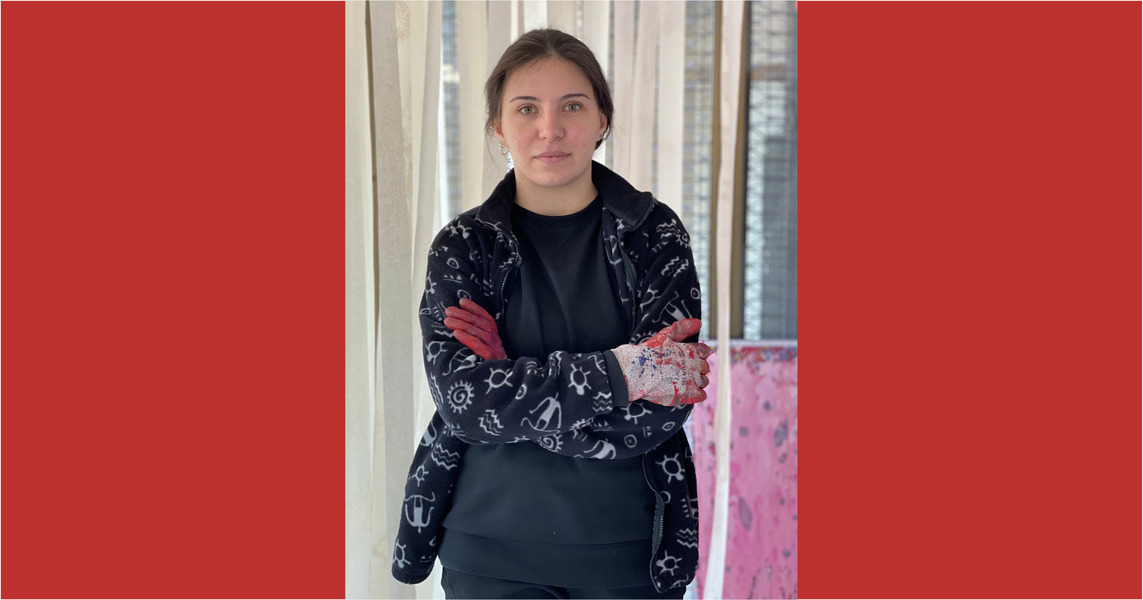
Iva Stankovska
Your last solo exhibition "All that is red is good?" opened in October 2020 at the Gallery of the Faculty of Fine Arts in Skopje, and this summer it was set at the Cultural Center in Struga. Let's start with it.
The exhibition was supposed to take place on Friday the 13th, March 13, 2020, and then everything closed due to the pandemic. So, it was postponed to October. That exhibition was ready even before that and its installation was already delayed for two years. I had worked on these pieces right after my graduation. I wanted to use them to evoke the worst that could happen, starting from my whole family history.
When I graduated from university, my father passed away, taking his own life. That literally happened on the first day when I moved into my new studio. This was very traumatic for me. When I look at those paintings now, it seems to me as if I were... I do not know how to explain it. All of it, how I went through it, how I understood it, all my questions, everything I thought and did not think about - everything is in those paintings, in those ideas.
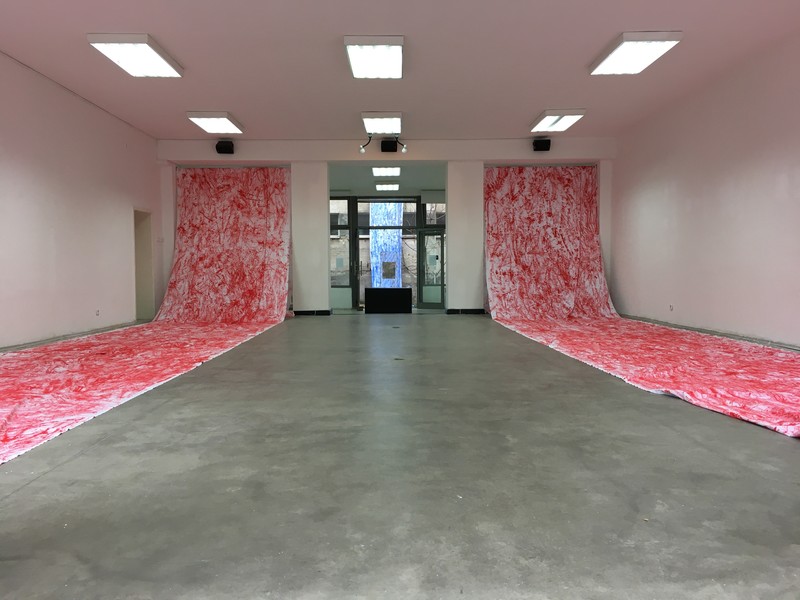
Iva Stankovska, "All that is red is good?", exhibition view, Gallery of the Faculty of Fine Arts, Skopje, October 2020
You mean to say that the exhibition consists of the whole emotional process that you were going through? Unintentionally?
Yes, well, yes, unintentionally. My starting point was the space, I wanted to use the space as it was, I wanted it to be a spatial exhibition specifically for that FLU gallery. The works themselves are made and originate from some of my interest in specific materials. For example, it is interesting how on its one side, the paper does not interact with alcohol, but on the other, it does [points to the cash register paper, strips hanging from the studio ceiling, site-specific installation "New plague, new studio, new rules", 2020]. That interest has led me to work with frozen paint, as well. But on the other hand, there are those paintings that were exhibited at the group exhibition "On the Edge" in Acanthus, which I experienced as a cleaning process. I later realized why I was doing it; it just took me a while.
In the works for the exhibition "All that is Red is Good?" I used my family’s traditions and superstitions. These are strange traditions that are disguised as some kind of religion that comes from these areas, such as some rituals involving chickens’ heads, such strange and morbid things that I have not encountered before. And following the general concepts of heaven, purgatory and hell, I incorporated these traditions into the works of the exhibition.
Are the mentioned family traditions and superstitions part of the spirituality that you want to translate in your work?
I don’t know how much I believe in all this, I probably don’t. But I wonder: why do we do it all? If one can deal with trauma with rituals involving chickens' heads, I deal with it this way, and for me it is a catharsis, it brings purification and closure. When I was done with the exhibition, for a whole month I felt as if a huge weight had been lifted of my shoulders.
I start with some material that interests me, for example, I am interested in working with epoxy resin. And I think to myself, what can I do with epoxy and how fast will it dry, what else can I put in it, and I start with something like that. I then realize what that process has meant to me.
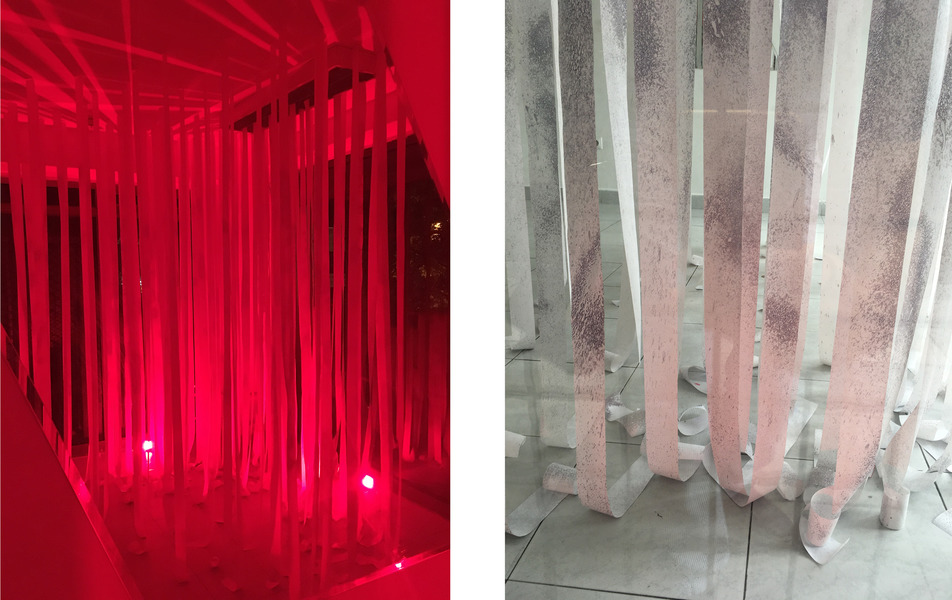
Iva Stankovska, "New plague, new studio, new rules“, Iva Stankovska's Studio, Skopje, June 2020
And why the color red?
Since my university days, I have kept going back to red. During the last year of my studies, I experimented with huge format canvases, I did everything I could think of with them. I lined them up, I don't know how many layers of canvases on top of each other, there were papers in between, or jute bags, I was leaving them outside in the snow, I painted them, I left a bigger canvas in the snow for two weeks. And I tried everything, I would buy all possible paints that can be found in stores for paints and varnishes, because I work with facade paints. The only color that kept its intensity, no matter how much I mixed it with others, was red; when mixed, all the others would become mud. And red just dilutes, doesn’t lose its intensity. I really liked that.
My thesis was a study on coincidence. Could I create a painting that is random, but at the same was made by me? And I realized that it does not work that way, because as long as you have an intention, the result is not accidental. Then when I was cleaning the studio, I noticed the nylons that were spread under the work, and actually they turned out to be the painting I was trying to create. I created it, but only because I had not intended for that nylon to be the painting. I exhibited the nylons after my graduation, but at the moment when I was preparing the text for the thesis, I didn’t know about them.
Does the creation of your work have a character of a ritual? You are showing us a process of tormenting of the material so that we can see, and probably so you can see yourself, what it can endure to become art work.
To be more exact, I wanted to test the limits of the canvas. In my garage, which I use as a depot, there are so many canvases, and they were just sitting there, looking like nothing. At exhibitions, I don’t exhibit them extended, because they are not made that way. When I exhibited them for my graduation, they were either thrown on the ground or placed on easels laying one over the other. They were made that way, there is no need to change their space.
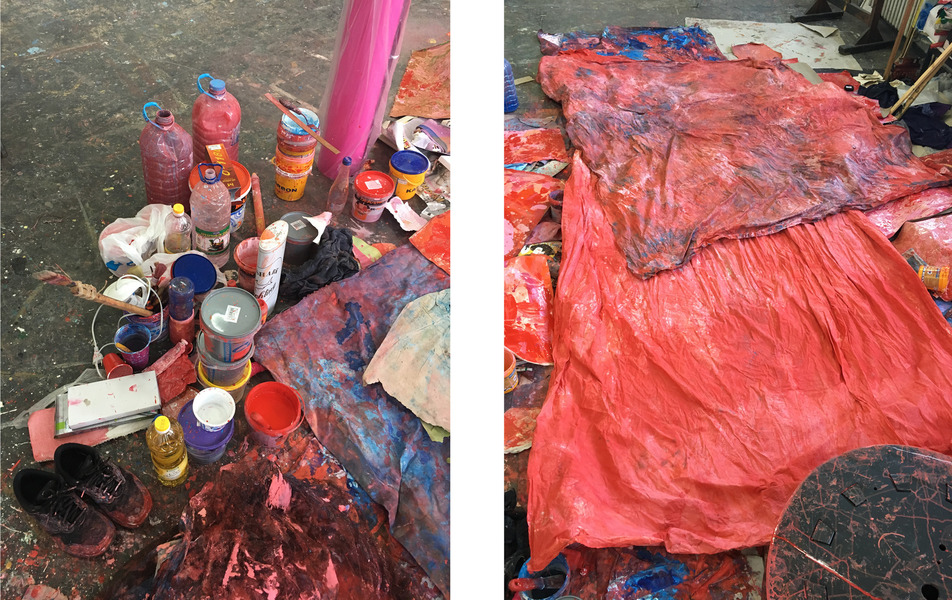
Iva Stankovska, graduation thesis research process, Faculty of Fine Arts, Skopje
Given your previous experiences with site-specific installations, can you compare the experience of working in virtual space and in a real life, through the exhibition "Incorporeal" realized within PrivatePrint Studio’s project VR Studio?
Both real and virtual spaces offer great opportunities, but they also bring their own unique challenges. In real spaces you can start without a precise idea of how to set up the exhibition and spontaneously design the space after studying it. This is also desirable because there are always technical difficulties that will sometimes bring about changes in the whole setting (eg: walls that cannot be nailed, certain holes, sockets, cables, doors, etc.).
In virtual spaces, on the other hand, you can realize the whole concept and idea of the setting from the beginning and achieve a perfectly clean and simple expression without disguises. You can play with natural phenomena and laws which I find super cool.
The VR Studio is meant to be a collaborative project. The exhibition is created between the artist, the designer, the curator, and the works don’t exist outside the virtual space. What do you think about the opportunity for this kind of collaboration?
I think that traditional techniques will certainly be with us for a long time, but the technology we have today, as much as our art, is a reflection of the times we live in and we should make good use of it. No man is an island, so I hope there will be more such collaborations.
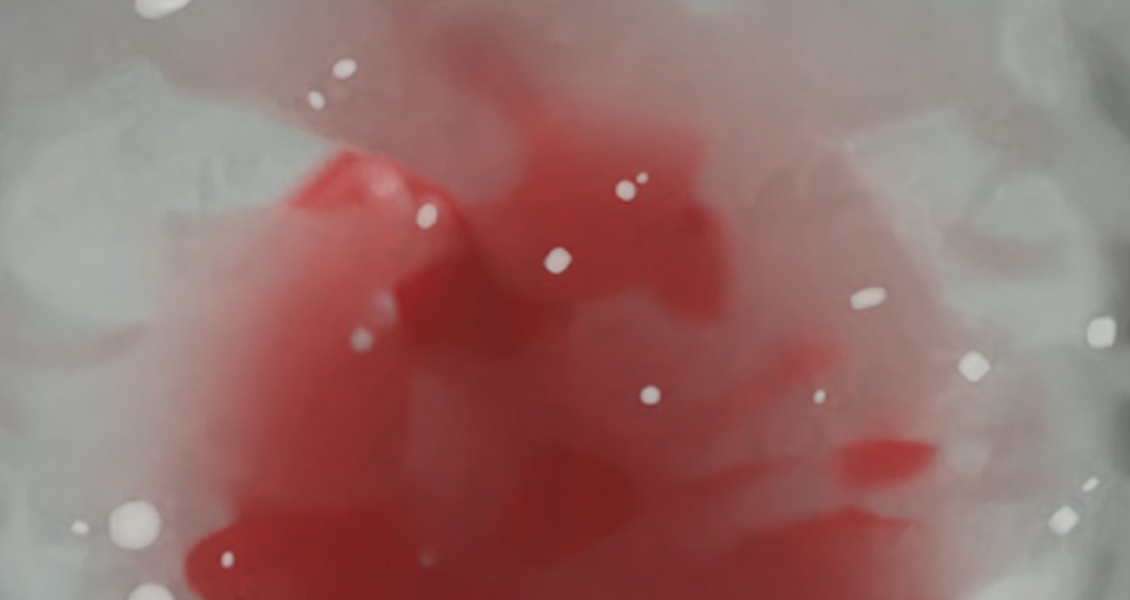
Iva Stankovska, "Incorporeal", virtual exhibition, PrivatePrint VR Studio, 2021
When you work in real space, you place the works directly in that space and intervene in it. Why do you want to change the space?
It is partly because I want to transform the space. Whether it’s about an exhibition I am creating or when I am an exhibition visitor, I am attracted by the play with space. During my last visit to the U.S., in the Guggenheim, on the top floor, in a room where in previous years there was nothing but a wall, there was the "Synthetic Desert" exhibition. It was set like a room within a room, soundproofed, when you enter you can hear others breathing and that is that. There was a bridge, a special blue light, and it looked literally like a desert with sponge pyramids on all sides. And nothing else.
So, you change the space to transport the viewers elsewhere?
That can be compared to how a work looks when placed in a studio and when it is exhibited in another space. I am interested in guiding the viewer in observing the work in a certain way and placing them in the space of the work.
Experience and material are extremely important, through the material you want to also represent experience. When you talk about museums, you are talking about your experience in them.
Those two things are the most important. When I started my studies at the Faculty of Fine Arts, coming from the arts high school, I realized that all of us from the arts high school paint in the same way, while everyone else that went to a different high school - differently. I was actively working to see what my style was and to see how far I could go. For example, we would have an exercise, an act, a portrait, whatever, I would do it, but in the meantime, I would make ten more drawings with markers, completely free style. Or another example, during an act class, the model stands where he or she stands, I draw the model, but I also draw everything around them, the students, their characters, the benches and so on. The works would get bigger, and by the end of college I worked on these big canvases, and after that only red canvases remained.
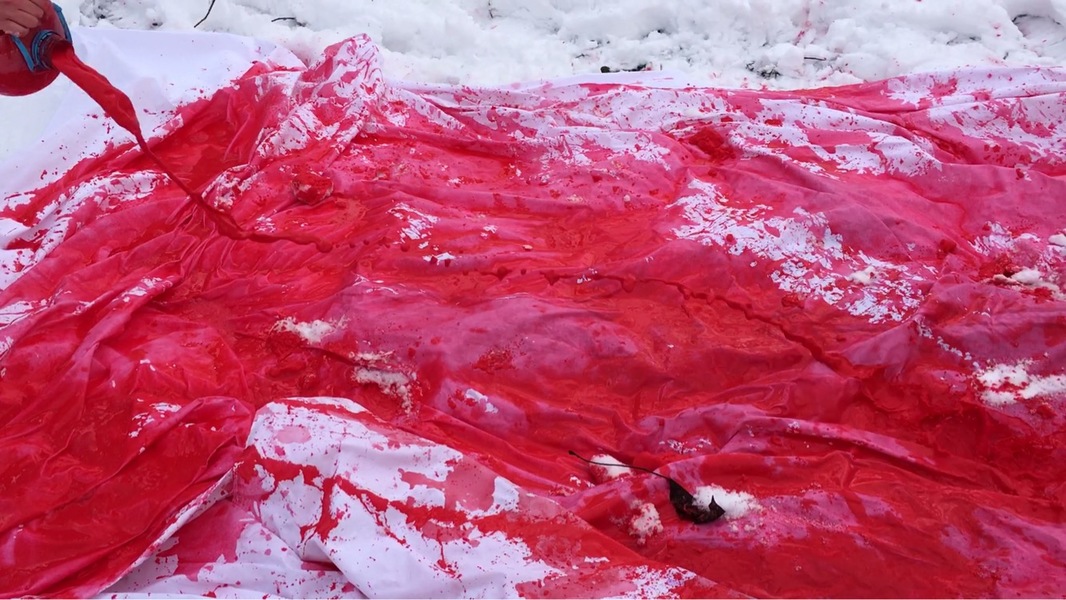
Iva Stankovska, graduation thesis research process, Faculty of Fine Arts, Skopje
An interesting process of moving away, moving away even further, and finally ending with complete abstraction.
It was a long process, which is still ongoing. Because I'm still testing how far I can go. It seems that some of my colleagues are still working in the same way as they did during their university days. When they draw a portrait, the measures are visible, the setting points are the same. I wanted to escape that.
Our PrivatePrint Meets programme targets young artists who are at the very beginning of their careers and who create in our local context. So, having that in mind, we would like to know how do you see the environment in which you work, the art scene which you belong to and the position of the artist?
There are many things I don’t like. First the institutions that don’t allow for anything, no freedom, and on the other hand they tell you that you are not creative. I have already given up on the idea of applying for projects... I don’t understand how during the whole process of making an exhibition, literally everyone from the driver to the cleaning personnel, meaning anyone involved, can be paid except for the artist, because the artist will get to exhibit their works in public, getting a free promotion. I still cannot understand that moment.
--
All photographs, except for the first one, are made by and/or courtesy of Iva Stankovska.
PrivatePrintMeets is a series of meetings with emerging artists from N. Macedonia, and is part of PrivatePrint’s project activities funded by the Prince Claus Network Partnership programme.
This year, the upgraded VR Studio is co-financed by the Ministry of Culture of the Republic of North Macedonia and made possible through our activities in the PrivatePrint Meets series funded by the Prince Claus Network Partnership Programme.